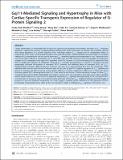| dc.contributor.author | Park-Windhol, Cindy | |
| dc.contributor.author | Zhang, Peng | |
| dc.contributor.author | Zhu, Ming | |
| dc.contributor.author | Su, Jialin | |
| dc.contributor.author | Chaves, Leonard | |
| dc.contributor.author | Maldonado, Angel E. | |
| dc.contributor.author | King, Michelle E. | |
| dc.contributor.author | Rickey, Lisa M. | |
| dc.contributor.author | Cullen, Darragh | |
| dc.contributor.author | Mende, Ulrike | |
| dc.date.accessioned | 2013-03-20T15:39:29Z | |
| dc.date.issued | 2012 | |
| dc.identifier.citation | Park-Windhol, Cindy, Peng Zhang, Ming Zhu, Jialin Su, Leonard Chaves, Angel E. Maldonado, Michelle E. King, Lisa Rickey, Darragh Cullen, and Ulrike Mende. 2012. Gq/11-mediated signaling and hypertrophy in mice with cardiac-specific transgenic expression of regulator of G-protein signaling 2. PLoS ONE 7(7): e40048. | en_US |
| dc.identifier.issn | 1932-6203 | en_US |
| dc.identifier.uri | http://nrs.harvard.edu/urn-3:HUL.InstRepos:10451760 | |
| dc.description.abstract | Cardiac hypertrophy is a well-established risk factor for cardiovascular morbidity and mortality. Activation of \(G_{q/11}\)-mediated signaling is required for pressure overload-induced cardiomyocyte (CM) hypertrophy to develop. We previously showed that among Regulators of G protein Signaling, RGS2 selectively inhibits \(G_{q/11}\) signaling and its hypertrophic effects in isolated CM. In this study, we generated transgenic mice with CM-specific, conditional RGS2 expression (dTG) to investigate whether RGS2 overexpression can be used to attenuate \(G_{q/11}\)-mediated signaling and hypertrophy in vivo. Transverse aortic constriction (TAC) induced a comparable rise in ventricular mass and ANF expression and corresponding hemodynamic changes in dTG compared to wild types (WT), regardless of the TAC duration (1-8 wks) and timing of RGS2 expression (from birth or adulthood). Inhibition of endothelin-1-induced \(G_{q/11}\)-mediated phospholipase C β activity in ventricles and atrial appendages indicated functionality of transgenic RGS2. However, the inhibitory effect of transgenic RGS2 on \(G_{q/11}\)-mediated PLCβ activation differed between ventricles and atria: (i) in sham-operated dTG mice the magnitude of the inhibitory effect was less pronounced in ventricles than in atria, and (ii) after TAC, negative regulation of \(G_{q/11}\) signaling was absent in ventricles but fully preserved in atria. Neither difference could be explained by differences in expression levels, including marked RGS2 downregulation after TAC in left ventricle and atrium. Counter-regulatory changes in other \(G_{q/11}\)-regulating RGS proteins (RGS4, RGS5, RGS6) and random insertion were also excluded as potential causes. Taken together, despite ample evidence for a role of RGS2 in negatively regulating \(G_{q/11}\) signaling and hypertrophy in CM, CM-specific RGS2 overexpression in transgenic mice in vivo did not lead to attenuate ventricular \(G_{q/11}\)-mediated signaling and hypertrophy in response to pressure overload. Furthermore, our study suggests chamber-specific differences in the regulation of RGS2 functionality and potential future utility of the new transgenic model in mitigating \(G_{q/11}\) signaling in the atria in vivo. | en_US |
| dc.language.iso | en_US | en_US |
| dc.publisher | Public Library of Science | en_US |
| dc.relation.isversionof | doi:10.1371/journal.pone.0040048 | en_US |
| dc.relation.hasversion | http://www.ncbi.nlm.nih.gov/pmc/articles/PMC3388988/pdf/ | en_US |
| dash.license | LAA | |
| dc.subject | Biology | en_US |
| dc.subject | Anatomy and Physiology | en_US |
| dc.subject | Cardiovascular System | en_US |
| dc.subject | Computational Biology | en_US |
| dc.subject | Molecular Genetics | en_US |
| dc.subject | Gene Expression | en_US |
| dc.subject | Genetics | en_US |
| dc.subject | Model Organisms | en_US |
| dc.subject | Animal Models | en_US |
| dc.subject | Mouse | en_US |
| dc.subject | Molecular Cell Biology | en_US |
| dc.subject | Signal Transduction | en_US |
| dc.subject | Signaling in Cellular Processes | en_US |
| dc.subject | G-Protein Signaling | en_US |
| dc.subject | Medicine | en_US |
| dc.subject | Integrative Physiology | en_US |
| dc.subject | Cardiovascular | en_US |
| dc.title | Gq/11-Mediated Signaling and Hypertrophy in Mice with Cardiac-Specific Transgenic Expression of Regulator of G-Protein Signaling 2 | en_US |
| dc.type | Journal Article | en_US |
| dc.description.version | Version of Record | en_US |
| dc.relation.journal | PLoS ONE | en_US |
| dash.depositing.author | Zhang, Peng | |
| dc.date.available | 2013-03-20T15:39:29Z | |
| dc.identifier.doi | 10.1371/journal.pone.0040048 | * |
| dash.contributor.affiliated | Rickey, Lisa M. | |
| dash.contributor.affiliated | Zhang, Peng | |


